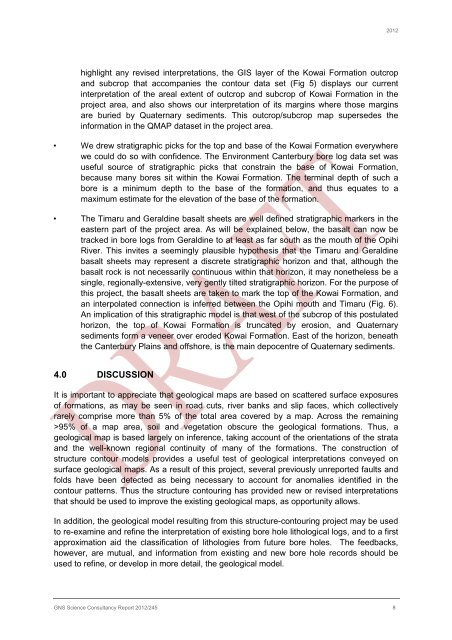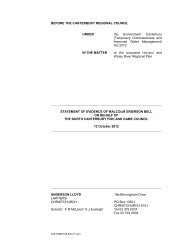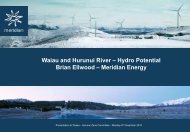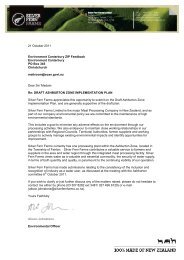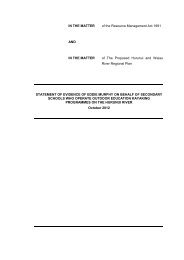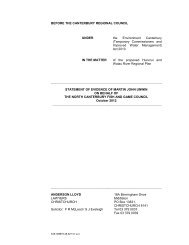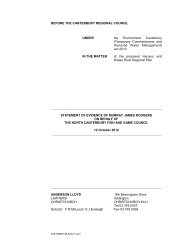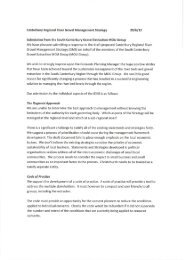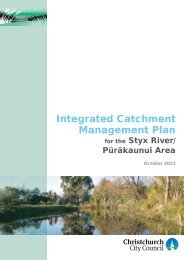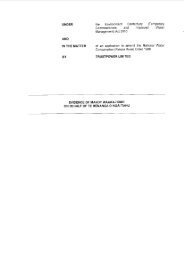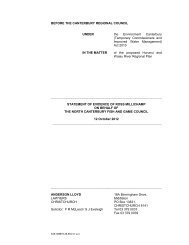Geological contours for groundwater modelling, South Canterbury
Geological contours for groundwater modelling, South Canterbury
Geological contours for groundwater modelling, South Canterbury
Create successful ePaper yourself
Turn your PDF publications into a flip-book with our unique Google optimized e-Paper software.
2012highlight any revised interpretations, the GIS layer of the Kowai Formation outcropand subcrop that accompanies the contour data set (Fig 5) displays our currentinterpretation of the areal extent of outcrop and subcrop of Kowai Formation in theproject area, and also shows our interpretation of its margins where those marginsare buried by Quaternary sediments. This outcrop/subcrop map supersedes thein<strong>for</strong>mation in the QMAP dataset in the project area.• We drew stratigraphic picks <strong>for</strong> the top and base of the Kowai Formation everywherewe could do so with confidence. The Environment <strong>Canterbury</strong> bore log data set wasuseful source of stratigraphic picks that constrain the base of Kowai Formation,because many bores sit within the Kowai Formation. The terminal depth of such abore is a minimum depth to the base of the <strong>for</strong>mation, and thus equates to amaximum estimate <strong>for</strong> the elevation of the base of the <strong>for</strong>mation.• The Timaru and Geraldine basalt sheets are well defined stratigraphic markers in theeastern part of the project area. As will be explained below, the basalt can now betracked in bore logs from Geraldine to at least as far south as the mouth of the OpihiRiver. This invites a seemingly plausible hypothesis that the Timaru and Geraldinebasalt sheets may represent a discrete stratigraphic horizon and that, although thebasalt rock is not necessarily continuous within that horizon, it may nonetheless be asingle, regionally-extensive, very gently tilted stratigraphic horizon. For the purpose ofthis project, the basalt sheets are taken to mark the top of the Kowai Formation, andan interpolated connection is inferred between the Opihi mouth and Timaru (Fig. 6).An implication of this stratigraphic model is that west of the subcrop of this postulatedhorizon, the top of Kowai Formation is truncated by erosion, and Quaternarysediments <strong>for</strong>m a veneer over eroded Kowai Formation. East of the horizon, beneaththe <strong>Canterbury</strong> Plains and offshore, is the main depocentre of Quaternary sediments.4.0 DISCUSSIONIt is important to appreciate that geological maps are based on scattered surface exposuresof <strong>for</strong>mations, as may be seen in road cuts, river banks and slip faces, which collectivelyrarely comprise more than 5% of the total area covered by a map. Across the remaining>95% of a map area, soil and vegetation obscure the geological <strong>for</strong>mations. Thus, ageological map is based largely on inference, taking account of the orientations of the strataand the well-known regional continuity of many of the <strong>for</strong>mations. The construction ofstructure contour models provides a useful test of geological interpretations conveyed onsurface geological maps. As a result of this project, several previously unreported faults andfolds have been detected as being necessary to account <strong>for</strong> anomalies identified in thecontour patterns. Thus the structure contouring has provided new or revised interpretationsthat should be used to improve the existing geological maps, as opportunity allows.In addition, the geological model resulting from this structure-contouring project may be usedto re-examine and refine the interpretation of existing bore hole lithological logs, and to a firstapproximation aid the classification of lithologies from future bore holes. The feedbacks,however, are mutual, and in<strong>for</strong>mation from existing and new bore hole records should beused to refine, or develop in more detail, the geological model.GNS Science Consultancy Report 2012/245 8


